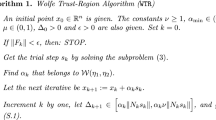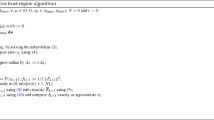Abstract
Rosenbrock methods are popular for solving a stiff initial-value problem of ordinary differential equations. One advantage is that there is no need to solve a nonlinear equation at every iteration, as compared with other implicit methods such as backward difference formulas or implicit Runge–Kutta methods. In this article, we introduce a trust-region technique to select the time steps of a second-order Rosenbrock method for a special initial-value problem, namely, a gradient system obtained from an unconstrained optimization problem. The technique is different from the local error approach. Both local and global convergence properties of the new method for solving an equilibrium point of the gradient system are addressed. Finally, some promising numerical results are also presented.
Similar content being viewed by others
References
Botsaris, C.A.: A class of methods for unconstrained minimization based on stable numerical integration techniques. J. Math. Anal. Appl. 63, 729–749 (1978)
Brown, A.A., Bartholomew-Biggs, M.C.: Some effective methods for unconstrained optimization based on the solution of systems of ordinary differential equations. J. Optim. Theory Appl. 62, 211–224 (1989)
Evtushenko, Yu.G.: Numerical Optimization Techniques. Optimization Software Publications, New York (1985)
Luo, X.L., Liao, L.-Z., Tam, H.W.: Convergence analysis of the Levenberg–Marquardt method. Optim. Methods Softw. 22, 659–678 (2007)
Schropp, J.: Using dynamical systems methods to solving minimization problems. Appl. Numer. Math. 18, 321–335 (1995)
Han, Q.M., Liao, L.-Z., Qi, H.D., Qi, L.Q.: Stability analysis of gradient-based neural networks for optimization problems. J. Glob. Optim. 19, 363–381 (2001)
Liao, L.-Z., Qi, H.D., Qi, L.Q.: Neurodynamical optimization. J. Glob. Optim. 28, 175–195 (2004)
Helmke, U., Moore, J.B.: Optimization and Dynamical Systems. Springer, Berlin (1994)
Łojasiewicz, S.: Sur les trajectoires de gradient d’une fonction analytique. Seminari di Geometria 1982–1983 (Lecture notes), pp. 115–117. Dipartemento di Matematica, Universita di Bologna (1984)
Absil, P.-A., Mahony, R., Andrews, B.: Convergence of the iterates of descent methods for analytic cost functions. SIAM J. Optim. 16(2), 531–547 (2005)
Lageman, C.: Konvergenz reell-analytischer gradientenähnlicher Systeme. Diplomarbeit im Fach Mathematik, Mathematisches Institut, Universität Würzburg, Germany (2002)
Grantham, W.J.: Trajectory following optimization by gradient transformation differential equations. In: Proceedings of the 42nd IEEE Conference on Decision and Control, Maui, HI, 9–12 December 2003, pp. 5496–5501
Hairer, E., Nørsett, S.P., Wanner, G.: Solving Ordinary Differential Equations I: Nonstiff Problems, 2nd edn. Springer, Berlin (1993)
Hairer, E., Wanner, G.: Solving Ordinary Differential Equations II: Stiff and Differential-Algebraic Problems, 2nd edn. Springer, Berlin (1996)
Humphries, A.R., Stuart, A.M.: Runge–Kutta methods for dissipative and gradient dynamical systems. SIAM J. Numer. Anal. 31, 1452–1485 (1994)
Stuart, A.M., Humphries, A.R.: The essential stability of local error control for dynamical systems. SIAM J. Numer. Anal. 32, 1940–1971 (1995)
Conn, A.R., Gould, N., Toint, Ph.L.: Trust-Region Methods. SIAM, Philadelphia (2000)
Nocedal, J., Wright, S.J.: Numerical Optimization. Springer, Berlin (1999)
Coffey, T.S., Kelley, C.T., Keyes, D.E.: Pseudotransient continuation and differential-algebraic equations. SIAM J. Sci. Comput. 25, 553–569 (2003)
Fowler, K.R., Kelley, C.T.: Pseudo-transient continuation for nonsmooth nonlinear equations. SIAM J. Numer. Anal. 43, 1385–1406 (2005)
Rosenbrock, H.H.: Some general implicit processes for the numerical solution of differential equations. Comput. J. 5, 329–331 (1963)
Shampine, L.F.: Implementation of Rosenbrock methods. ACM Trans. Math. Softw. 8, 93–113 (1982)
Shampine, L.F., Reichelt, M.W.: The Matlab ODE suite. SIAM J. Sci. Comput. 18, 1–22 (1997)
Kelley, C.T., Liao, L.-Z., Qi, L.Q., Chu, M.T., Reese, J.P., Winton, C.: Projected pseudotransient continuation. SIAM J. Numer. Anal. 46, 3071–3083 (2008)
Higham, D.J.: Trust region algorithms and timestep selection. SIAM J. Numer. Anal. 37, 194–210 (1999)
Luo, X.L.: Singly diagonally implicit Runge–Kutta methods combining line search techniques for unconstrained optimization. J. Comput. Math. 23, 153–164 (2005)
Kelley, C.T., Keyes, D.E.: Convergence analysis of pseudo-transient continuation. SIAM J. Numer. Anal. 35, 508–523 (1998)
Deuflhard, P.: Newton Methods for Nonlinear Problems: Affine Invariance and Adaptive Algorithms. Springer, Berlin (2004)
Fletcher, R.: Practical Methods of Optimization. Wiley, New York (1987)
Levenberg, K.: A method for the solution of certain problems in least squares. Q. Appl. Math. 2, 164–168 (1944)
Marquardt, D.: An algorithm for least-squares estimation of nonlinear parameters. SIAM J. Appl. Math. 11, 431–441 (1963)
Yuan, Z.D., Fei, J.G., Liu, D.G.: The Numerical Solutions for Initial Value Problems of Stiff Ordinary Differential Equations. Science Press, Beijing (1987) (in Chinese)
Luo, X.L.: Unconstrained optimization methods based on dynamic systems (in Chinese). Ph. D. thesis, Institute of Computational Mathematics and Scientific Engineering/Computing, Chinese Academy of Sciences (2001) (in Chinese)
Luo, X.L.: Convergence analysis of methods based on BDF for unconstrained optimization. Math. Numer. Sinica 25, 177–184 (2003) (in Chinese)
Powell, M.J.D.: Convergence properties of a class of minimization algorithms. In: Mangasarian, O.L., Meyer, R.R., Robinson, S.M. (eds.) Nonlinear Programming, vol. 2, pp. 1–27. Academic Press, New York (1975)
Dennis, J.E., Moré, J.J.: A characterization of superlinear convergence and its application to quasi-Newton methods. Math. Comput. 28, 549–560 (1974)
Moré, J.J., Garbow, B.S., Hillstrom, K.E.: Testing unconstrained optimization software. ACM Trans. Math. Softw. 7, 17–41 (1981)
MATLAB 6.5: The MathWorks Inc., http://www.mathworks.com (2003)
Author information
Authors and Affiliations
Corresponding author
Additional information
Communicated by T.L. Vincent.
This research was supported in part by Grant 2007CB310604 from National Basic Research Program of China, and #DMS-0404537 from the United States National Science Foundation, and Grant #W911NF-05-1-0171 from the United States Army Research Office, and the Research Grant Council of Hong Kong.
Rights and permissions
About this article
Cite this article
Luo, XL., Kelley, C.T., Liao, LZ. et al. Combining Trust-Region Techniques and Rosenbrock Methods to Compute Stationary Points. J Optim Theory Appl 140, 265–286 (2009). https://doi.org/10.1007/s10957-008-9469-0
Published:
Issue Date:
DOI: https://doi.org/10.1007/s10957-008-9469-0




